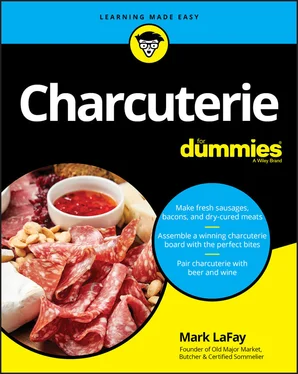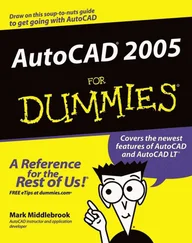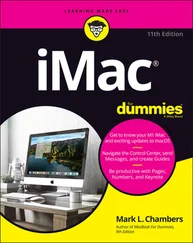Cranking a stuffer can at times require some shoulder and arm strength. Depending on how firm your meat mixture is, you will want to make sure that the stuffer you select either comes with clamps to hold it down to your work surface, or at minimum has enough surface area on the base of the stuffer to use bench clamps like the ones pictured in Figure 1-7.
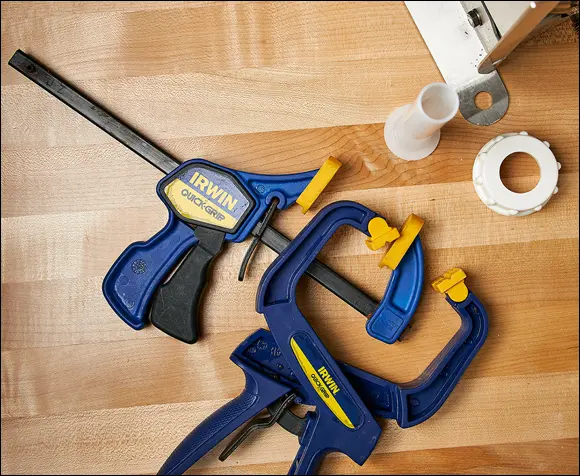
Photo by David Pluimer
FIGURE 1-7:Bench clamps for your stuffer.
The meat slicer (a.k.a. deli slicer) is a motorized device for easily and uniformly slicing meats. Meat slicers come in all shapes and sizes (like the one shown in Figure 1-8), and while they are not absolutely mission-critical for making meats, they are extremely helpful when you get to finishing up your bacon, or other meats from which you want to have slices ready to go.

Photo by David Pluimer
FIGURE 1-8:Meat slicer slicing bacon.
A seemingly endless number of meat slicers are available. The usefulness of your slicer will be largely determined by the size of the product that you plan to slice. If the sole purpose of your deli slicer will be to slice bacon, then you will want, at minimum, a 10-inch slicer — and possibly a 12-inch slicer — depending on the size of the pork belly you want to slice. Popular and reliable brands of slicers include
Berkel
Bizerba
Hobart
Globe
Several consumer brands with lower-end and lower-cost options are also available.
A great smokehouse is a great thing! Have you ever had barbeque that made you groan with contentment? Or, how about bacon that kept you coming back for another strip? Have you ever wept when the last piece of bacon was eaten? Asking for a friend.
There are several ways to smoke, and there are several outcomes that you can have. The most important quality in a smoker is whether or not you can run it and make tasty food that is safe to eat. For the purposes of this book, I focus on hot smoking, which is smoking at temperatures over 100 degrees Fahrenheit. The goal is to cook your product to a temperature that kills off any potentially harmful bacteria, while applying a smoke flavor to the meat. Following is a list of smokers you can buy.
Electric smoker: Electric smokers (see Figure 1-9) are a delightful creation because they offer automated digital temperature control. Electric smokers also smolder wood chips using an electric heating element which requires no lighting or maintaining. You can acquire an electric smoker for your home at a reasonable price, and aside from the periodic requirement to reload it with wood chips, it will be largely “set and forget.”The Sausage Maker FIGURE 1-9:Electric smoker.
Pellet smoker: Pellet smokers are fully automated electric smokers. These smokers use compressed hardwood sawdust that is held together with paraffin to generate heat and smoke. Did I mention that they are fully automated? The smoke is never as heavy as you’ll get with an electric wood chip smoker, but you do get a whole lot of convenience.
Gas-burning smoker: Gas-burning smokers (see Figure 1-10) are more like a traditional grill in that they use a propane burner to generate heat and smolder the wood in order to generate smoke. Gas burners require frequent monitoring to ensure that you are getting a steady heat output. The benefit is that you can smolder larger pieces of wood, which some enthusiasts would argue gives you a better smoke flavor.
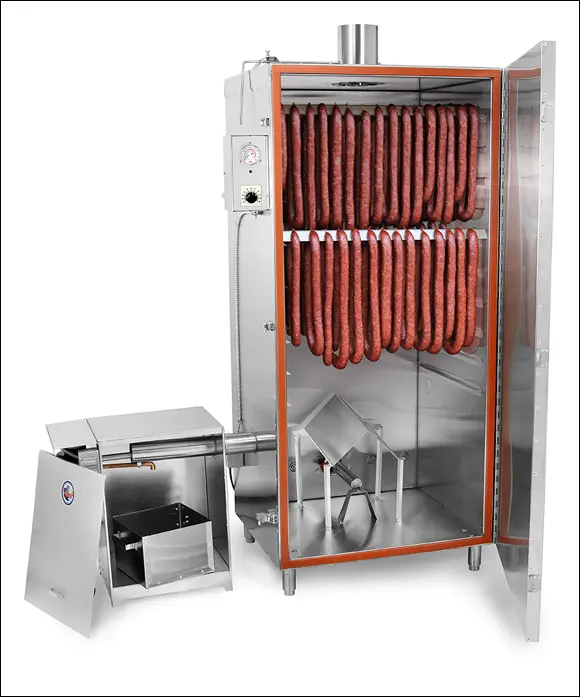
The Sausage Maker
FIGURE 1-10:Gas-burning smoker.
Later in this book, you learn how to make dry-cured meats like salami and prosciutto. In order to dry-cure meat, you need to be able to control temperature, humidity, and airflow. Unless you have a sweet 200-year-old barn in the hills of Tuscany, it can be a chore to replicate the type of environment you will need to produce dry-cured products. Never fear, though; you have a couple of options. Your first option is to purchase a dry-curing chamber like the one pictured in Figure 1-11.
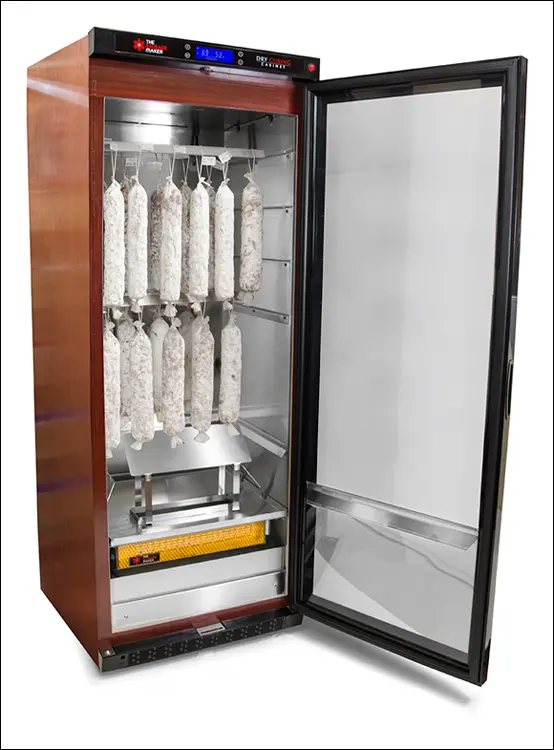
The Sausage Maker
FIGURE 1-11:Ready-made dry-curing chamber.
The dry-curing chamber controls both its internal humidity and temperature to ensure you get slow, controlled drying. The downside to this type of device is the cost.
Your second option is to construct your own dry-curing chamber. You can do this with a working refrigerator, and some relatively inexpensive sensors and controls like those pictured in Figure 1-12. The detailed process for building your own chamber is outside the scope of this book. However, if there’s an internet search engine, there’s a way!
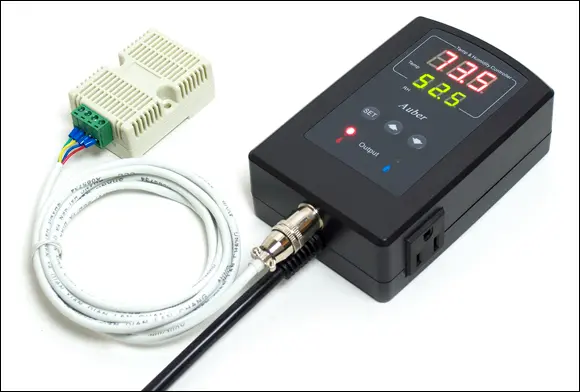
Auber Instruments
FIGURE 1-12:Humidity and temperature control sensors for a homemade curing chamber.
Humans have been preserving meats without modern technology for a few thousand years now. Methods of fermenting (to control acidity of meat), salting, and drying have been handled by family lore, which often included tracking.
Today we have the benefit of a great deal of science that has helped shed light on why things were done a certain way. Shelf stability is a term used to describe the condition of a food product that doesn’t need refrigeration. You create shelf stability in meat by controlling the amount of water (water activity, a w ) in the meat through salting and drying. In the case of salami, you also manage it by increasing the acidity of the meat, which is measured in pH.
Explaining water activity in a straightforward manner is no simple task. It is a scientific way of determining how much water is available in something. Water is required for bacteria and other organic pathogens to be able to live and replicate. As a result, the best way to limit the growth of bacteria, which can be potentially harmful and cause spoilage, is to eliminate as much of the water as possible. A substantial amount of research is available on the internet to explain the correlation between water activity and shelf stability.
Water activity ( a w ) meters are largely cost prohibitive for the home enthusiast, so I will focus on Old World methods of tracking water loss through weight loss over time to determine the safety of your meat products. However, if you have the resources and the desire to take that extra step toward safety, the leading producer of water activity meters is the METER Group.
With food, acidity is best described as how sour something tastes; the more sour it is, the more acidic it is. When making salami, one of the requirements for safety is to lower the pH — that is, to make it acidic — so that bacteria is unable to grow in the interior of the salami while it dries. There are many ways to increase acidity (lower pH), which you will learn about in Chapter 7. You will find that pH meters are both affordable and necessary when you start making your own salami. There is no way to safely approximate the pH of a meat product without testing it.
Читать дальше
